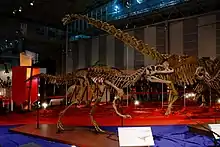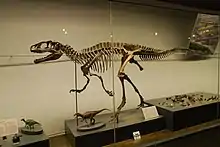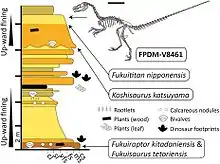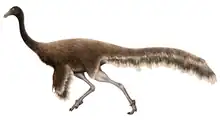Fukuiraptor
Fukuiraptor ("thief of Fukui") was a medium-sized megaraptoran theropod dinosaur of the Early Cretaceous epoch (either Barremian or Aptian) that lived in what is now Japan.[1] Fukuiraptor is known from the Kitadani Formation[2] and possibly also the Sebayashi Formation.[3]
| Fukuiraptor Temporal range: Early Cretaceous, | |
|---|---|
 | |
| Reconstructed skeleton | |
| Scientific classification | |
| Domain: | Eukaryota |
| Kingdom: | Animalia |
| Phylum: | Chordata |
| Clade: | Dinosauria |
| Clade: | Saurischia |
| Clade: | Theropoda |
| Clade: | †Megaraptora |
| Genus: | †Fukuiraptor Azuma & Currie, 2000 |
| Type species | |
| †Fukuiraptor kitadaniensis Azuma & Currie, 2000 | |
Description and history


The type specimen is a partial skeleton (designated FPDM-V97122) discovered in the Kitadani quarry near Katsuyama in the Fukui prefecture. It is thought that this specimen was not mature and an adult may have been larger. The remains of many other individuals have been found in the quarry, with numerous humeri, femurs, and teeth being assigned to this species.[2] However, the other individuals recovered from the same locality are mostly juveniles that were smaller than the holotype (Currie & Azuma, 2006), in the smallest case less than a quarter of the holotype's size. A tooth (NDC-P0001) discovered in a block of conglomerate from the Sebayashi Formation has been referred to Fukuiraptor as well.[4] As indicated by its slender phalanges, Fukuiraptor was a relatively lightly built animal, regardless of its maturity.[1] In 2010 Gregory Paul gave a length of 5 meters (16 ft) and a weight of 300 kg (660 lbs).[5] Molina-Pérez and Larramendi estimated a length of 4.3 meters (14.1 ft) and a weight of 590 kg (1,300 lbs) in 2016.[6]
The distinctive teeth of Fukuiraptor show similarities with both carcharodontosaurids (being very compressed and blade-like, as well as having wrinkled enamel) and tyrannosaurids (having oblique blood grooves near the serrations).[2] The holotype also had very large and flat manual unguals (hand claws), which played a role in its initial classification as a dromaeosaurid (as the hand claws were mistaken for foot claws) as well as its current classification as a megaraptoran.[7]
Classification
Initially considered a member of the Dromaeosauridae when first discovered, its initial describers considered it a carnosaur, related to Allosaurus. More recent studies consider it a megaraptoran, an enigmatic group which may have been part of the family Neovenatoridae.[7] However, more recently, another analysis has proposed that all megaraptorans are actually tyrannosauroids, which would reclassify Fukuiraptor as a tyrannosauroid coelurosaur.[8] Recent cladistic analysis of the theropod Gualicho has suggested that Fukuiraptor and other megaraptorans are either allosauroids, or non-tyrannosauroid basal coelurosaurs.[9]
Below is a cladogram reconstructing the position of Fukuiraptor in the Megaraptora as per Delcourt and Grillo, 2018.[10]
| Megaraptora |
| |||||||||||||||||||||||||||
It has been suggested that Fukuiraptor is a close relative to the Australian Megaraptoran known as Australovenator, however some studies place Australovenator as a derived Megaraptoran which actually forms a clade with the South American Megaraptorans known as Megaraptoridae.
Palaeoecology

In the Kitadani Formation, where fossils of Fukuiraptor have been recovered,[1] fossils of other vertebrates have been preserved. Among the species that have been properly described and named are Fukuisaurus tetoriensis,[11] a styracostern ornithischian, Fukuititan nipponensis,[12] a titanosauriform sauropod, Koshisaurus katsuyama,[13] a hadrosauroid ornithischian, Fukuivenator paradoxus,[14] a therizinosaurian theropod, and Fukuipteryx prima,[15] an avialan as defined by the authors.
External links
- Image of the holotype skeleton, published by the twitter account of Thomas Holtz
- "Fukuiraptor kitadaniensis". Fukui Prefectural Dinosaur Museum. Archived from the original on 29 August 2006.
References
- Azuma, Yoichi; Philip J., Currie (2000). "A new carnosaur (Dinosauria: Theropoda) from the Lower Cretaceous of Japan" (PDF). Canadian Journal of Earth Sciences. 37 (12): 1735–1753. Bibcode:2000CaJES..37.1735A. doi:10.1139/e00-064.
- Currie, P.J.; Azuma, Y. (2006). "New specimens, including a growth series, of Fukuiraptor (Dinosauria, Theropoda) from the Lower Cretaceous Kitadani Quarry of Japan". J. Paleont. Soc. Korea. 22 (1): 173–193 – via ResearchGate.
- "A tooth of Fukuiraptor aff. F. kitadaniensis from the Lower Cretaceous Sebayashi Formation, Sanchu Cretaceous, Japan: 東京学芸大学リポジトリ". ir.u-gakugei.ac.jp. Retrieved 9 October 2020.
- Molnar, Ralph E.; Obata, Ikuwo; Tanimoto, Masahiro; Matsukawa, Masaki (2009). "A tooth of Fukuiraptor aff. F. kitadaniensis from the Lower Cretaceous Sebayashi Formation, Sanchu Cretaceous, Japan". Bulletin of Tokyo Gakugei University, Division of Natural Sciences. 61: 105–117 – via ResearchGate.
- Paul, Gregory S. (2010). The Princeton Field Guide to Dinosaurs. New Jersey: Princeton University Press. p. 98.
- Molina-Pérez & Larramendi (2016). Récords y curiosidades de los dinosaurios Terópodos y otros dinosauromorfos. Barcelona, Spain: Larousse. p. 263.
- Benson, R. B. J.; Carrano, M. T.; Brusatte, S. L. (2010). "A new clade of archaic large-bodied predatory dinosaurs (Theropoda: Allosauroidea) that survived to the latest Mesozoic". Naturwissenschaften. 97 (1): 71–78. Bibcode:2010NW.....97...71B. doi:10.1007/s00114-009-0614-x. PMID 19826771. S2CID 22646156.
- Novas, F. E.; Agnolín, F. L.; Ezcurra, M. D.; Canale, J. I.; Porfiri, J. D. (2012). "Megaraptorans as members of an unexpected evolutionary radiation of tyrant-reptiles in Gondwana". Ameghiniana. 49 (4(R): Suplemento Resúmenes [Abstracts]): R33.
- Apesteguía, Sebastián; Smith, Nathan D.; Valieri, Rubén Juárez; Makovicky, Peter J. (13 July 2016). "An Unusual New Theropod with a Didactyl Manus from the Upper Cretaceous of Patagonia, Argentina". PLOS ONE. 11 (7): e0157793. Bibcode:2016PLoSO..1157793A. doi:10.1371/journal.pone.0157793. ISSN 1932-6203. PMC 4943716. PMID 27410683.
- Delcourt, Rafael; Grillo, Orlando Nelson (15 December 2018). "Tyrannosauroids from the Southern Hemisphere: Implications for biogeography, evolution, and taxonomy". Palaeogeography, Palaeoclimatology, Palaeoecology. 511: 379–387. doi:10.1016/j.palaeo.2018.09.003. ISSN 0031-0182. S2CID 133830150.
- Kobayashi, Yoshitsugu; Azuma, Yoichi (11 April 2003). "A new iguanodontian (Dinosauria: Ornithopoda) from the Lower Cretaceous Kitadani Formation of Fukui Prefecture, Japan". Journal of Vertebrate Paleontology. 23 (1): 166–175. doi:10.1671/0272-4634(2003)23[166:anidof]2.0.co;2. ISSN 0272-4634. S2CID 131386181.
- Azuma, Yoichi; Shibata, Masateru (2010). "Fukuititan nipponensis, A New Titanosauriform Sauropod from the Early Cretaceous Tetori Group of Fukui Prefecture, Japan". Acta Geologica Sinica - English Edition. 84 (3): 454–462. doi:10.1111/j.1755-6724.2010.00268.x. ISSN 1755-6724. S2CID 128897110.
- "New basal hadrosauroid (Dinosauria: Ornithopoda) from the Lower Cretaceous Kitadani Formation, Fukui, central Japan" (PDF). Zootaxa.
- Azuma, Yoichi; Xu, Xing; Shibata, Masateru; Kawabe, Soichiro; Miyata, Kazunori; Imai, Takuya (23 February 2016). "A bizarre theropod from the Early Cretaceous of Japan highlighting mosaic evolution among coelurosaurians". Scientific Reports. 6 (1): 20478. doi:10.1038/srep20478. ISSN 2045-2322. PMC 4763874. PMID 26908367.
- Imai, Takuya; Azuma, Yoichi; Kawabe, Soichiro; Shibata, Masateru; Miyata, Kazunori; Wang, Min; Zhou, Zhonghe (14 November 2019). "An unusual bird (Theropoda, Avialae) from the Early Cretaceous of Japan suggests complex evolutionary history of basal birds". Communications Biology. 2 (1): 399. doi:10.1038/s42003-019-0639-4. ISSN 2399-3642. PMC 6856171. PMID 31754639.

.jpg.webp)












